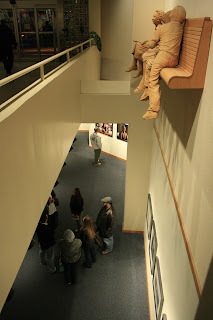
On Wednesday November 17 Dillon and I had the opportunity to go downtown to the Museum of Arts and Culture to listen to a lecture series given by the director of Survival Research Laboratories, Mark Pauline. Mark spent his late teen in the work force learning the difficult labor-intensive way that many Americans make a living. After just a few short years he decided he needed to go to college and after graduating college he began SRL in 1978 in San Francisco.
After his short experience in the defense engineering industry, Mark got tired of making things to hurt people and wanted to extract the hidden entertainment from these robotic machines. He felt as though everyone lives with a certain level of fear about the technologies that surround them, so he created SRL to extract the innate fear of technologies from his audience.
SRL’s focus is to create an orchestra of machines that terrify us while at the same time make socio-political, satirical commentary. A typical show put on by SRL spans anywhere between 15 and 45 minutes long and has a budget between $10,000 to $400,000. Mark personally determines the show size by tonnage of the combined robots, which can range anywhere from 10 to 100 tons of equipment. Many of the shows include elements that intentionally overload your senses, for example in many shows he has screeching, smaller jet engines, grinding, banging and my personal favorite the v1 buzz bomber, loud enough to be heard from 21 miles away.
The artist lecture, opened the public's eyes to a new kind of art, an art that attempts to be "the most original kind of art"-- art that is so complicated that it has never been done before, and shows that require so much time that it will never be done again. We feel that we are connected to this type of work because we feel that any artist's main goal is to be "the most original". Mark stated how his work was so far disconnected from reality, that he needed no explanation behind his intentions, other than "that's just the way things are". What determines if a work is original? Is there a point in time that no matter what one does, it was already done before, and we're just trying to make it better? Does a work have to be original to be good, or is the minimum alteration of “10%” going to become standard?













